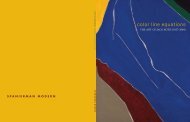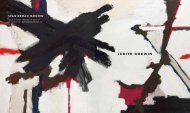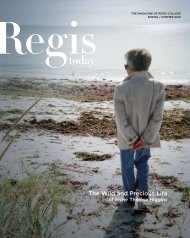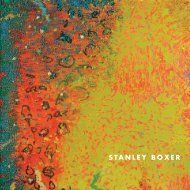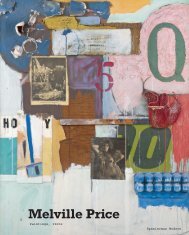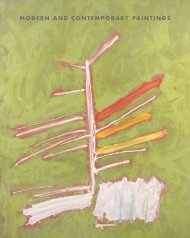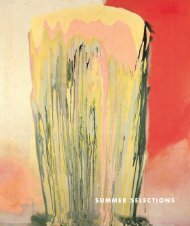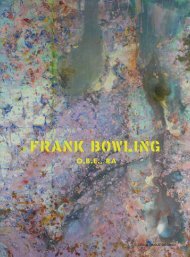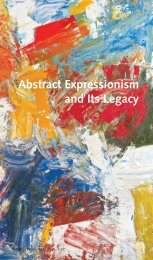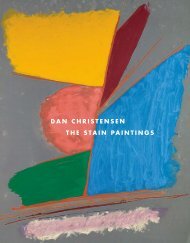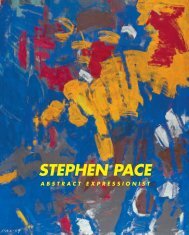View the catalogue - Spanierman Modern
View the catalogue - Spanierman Modern
View the catalogue - Spanierman Modern
You also want an ePaper? Increase the reach of your titles
YUMPU automatically turns print PDFs into web optimized ePapers that Google loves.
Cubism, along with Helen Frankenthaler,<br />
from Wallace Harrison, a French-trained<br />
artist. In 1949 she accepted a position<br />
teaching art at Leonard School for Girls.<br />
She also taught at a number of art schools<br />
and at <strong>the</strong> Museum of <strong>Modern</strong> Art, which<br />
deepened her understanding of currents<br />
in twentieth-century modernism.<br />
Park and Brooks were married in 1947,<br />
and two years later <strong>the</strong>y established studios<br />
in Montauk, Long Island. Afterwards <strong>the</strong>y<br />
lived in The Springs, East Hampton, where<br />
Park continues to reside.<br />
Watching <strong>the</strong> New York School unfold,<br />
Park demonstrated her integral part in this<br />
emergence, launching her own version of<br />
Abstract Expressionism within three years.<br />
By 1952 she had begun to show her work,<br />
participating in an invitational show at<br />
Peridot, a contemporary New York gallery.<br />
A review of <strong>the</strong> exhibition in Artnews gave<br />
recognition to a “black, maize and pink”<br />
painting she displayed. In <strong>the</strong> next year, she<br />
was represented in <strong>the</strong> painting annual of<br />
<strong>the</strong> Whitney Museum of American Art in New<br />
York, which constituted her first important<br />
museum exhibition. In 1954 Park participated<br />
in Fifteen Artists of <strong>the</strong> Region, an exhibition<br />
at Guild Hall in East Hampton, New York,<br />
which also included works by Franz Kline,<br />
Joan Mitchell, and Larry Rivers. Stuart Preston,<br />
in a review of <strong>the</strong> show in New York Times<br />
praised Park as a ‘high-spirited colorist.’ 3<br />
When Park’s work was displayed in 1955<br />
at Tanager Gallery in New York—which<br />
showcased artists on <strong>the</strong> leading edge—<br />
her organization of color was highlighted in<br />
a Village Voice article, while Dore Ashton<br />
stated in a New York Times review of a<br />
show held <strong>the</strong> following year: “Among<br />
paintings, <strong>the</strong>re are notable abstractions<br />
by Charlotte Park, who shows a strong<br />
black-and-white.” 4 During <strong>the</strong> 1950s Park<br />
participated in annuals and group shows<br />
at Stable Gallery in New York and Signa<br />
Gallery in East Hampton, both of which<br />
had significant Abstract Expressionist ties.<br />
Park’s one-person exhibition at Tanager<br />
in November 1957 prompted enthusiastic<br />
responses. Ashton wrote in <strong>the</strong> New York<br />
Times that Park’s “recent abstractions . . . are<br />
crisp, well-composed works, moving close<br />
to <strong>the</strong> surface of <strong>the</strong> canvas. Some are very<br />
active in movement, suggesting a flooding<br />
openness, as if her <strong>the</strong>me were <strong>the</strong> sea.<br />
O<strong>the</strong>rs are more quiet, with resounding<br />
forms in orange or red held in a rich black<br />
matrix. By scraping, building up and revisiting,<br />
Miss Park has achieved a varied, sensuously<br />
appealing surface.” 5<br />
The awareness that Park’s art deserved<br />
greater attention than it had during <strong>the</strong><br />
era of Abstract Expressionism began to be<br />
acknowledged in <strong>the</strong> late 1970s and early<br />
1980s. Park was among <strong>the</strong> artists chosen<br />
to be represented in <strong>the</strong> exhibition, Around<br />
Jackson Pollock, East Hampton, 1946–55:<br />
15 Abstract Expressionists, which was held in<br />
Paris at <strong>the</strong> American Cultural Center in <strong>the</strong><br />
fall of 1979. Flora Lewis, who reviewed <strong>the</strong><br />
exhibition for <strong>the</strong> New York Times, remarked<br />
that <strong>the</strong> show “situates <strong>the</strong> movement and<br />
gives a sense of its spread,” while noting that<br />
<strong>the</strong> painters, chosen to represent Pollock’s<br />
circle by Virginia Zabriskie, included Ibram<br />
Lassaw, de Kooning, Franz Kline, Robert<br />
6



